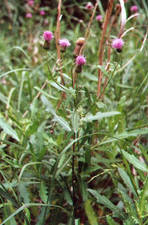Marc Montefusco
Frederick County Master Gardener Program
Tilling wet soil (and I presume you mean with a roto-tiller) will actually damage soil structure, and can leave you with concrete-like lumps that make planting, cultivation, and even plant growth more difficult. The rule of thumb, or in this case,
fist, is to make a ball of soil in your clenched hand. If it's a runny, sticky mess, the soil is too wet to till. If you can't make it stick together at all, the soil is too dry. If it forms a ball that breaks apart when you poke it, it's probably just right. The next time
your husband claims that excessive moisture prevents him from carrying out your every wish, perform this little test yourself and confront him with the results. Normally, the best time for tilling is two or three days after a rain, providing that the ground wasn't saturated
to begin with.
For those of you without a tiller, male or mechanical, there are basically three kinds available on the market. The forward-tine tiller (tines are the mechanical teeth that do the work of mixing the soil) is the most common and least expensive
full-size tiller. The circular movement of the tines propels the machine forward, a metal stake provides resistance to help the teeth dig in, and you provide direction and in some cases, even more resistance. Most modern tillers of any variety have a safety switch that
turns the machine off if you lose control. Forward-tine tillers are maneuverable in tight spaces, but can require a lot of strength to wrestle around. A reverse gear is available on some models, which in addition to providing better handling can be useful in dislodging
stuck rocks.
Rear-tine tillers are the largest and most expensive tillers. Forward motion is provided by a pair of tractor wheels, and the tines normally rotate in the opposite direction. These tillers are great for larger, straight row situations. Most have
reverse gears, several have power take-offs that can be used to drive other devices. For serious gardeners with large plots and hefty budgets, rear-tine tillers are a good investment.
|

Canada thistle
(Cirsium arvense)
|
Mini-tillers have become very popular in recent years. They are most useful for cultivating beds after they have already been prepared and planted - you wouldn't want to till a large plot with one of these. Most people who have them love them,
although there seems to some difference in quality between brands - get recommendations from friends or professionals before you buy.
A few words on tilling in general: don't rely entirely on tilling for good soil maintenance. Even the biggest tillers only work the soil down to about seven inches below the surface. Repeated tilling can create an impacted layer below the tilled area
which impedes drainage and root growth. For small plots, use a spading fork periodically to break up this hard layer. Those of you with larger gardens may want to hire someone to plow every few years, or plow it yourself if you have the equipment. Tilling also has a few
other drawbacks: it can break up soil structure over time, it can destroy earthworms, and it can serve as a propagating tool for weeds like Canadian thistle and bindweed, which will re-sprout from the tiny pieces of root that the tiller leaves in its wake.
Read other articles on gardening techniques